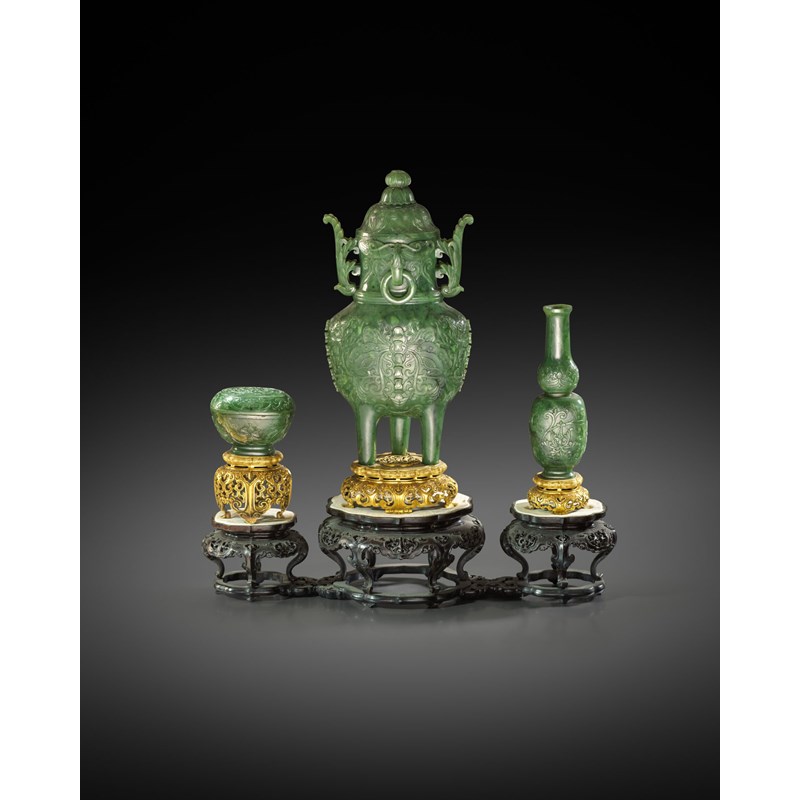The Lawrence Jade Collection - 14 Nov 2023
A SET OF THREE FINE CHINESE SPINACH-GREEN JADE ALTAR VESSELS
A SET OF THREE FINE CHINESE SPINACH-GREEN JADE ALTAR VESSELS
QIANLONG 1736-95
Comprising: a tall tripod incense burner and cover of archaic ding form with butterflies to the neck suspending loose rings and two upright handles formed as leaves, a slender gourd-shaped incense tool vase rising from a short flared foot to an inverted rim, and an oval box with a domed cover, each decorated in relief with stylised floral scrolls and sprays, the deep green stone of each vessel with black specks and dark inclusions, each item raised on an elaborate openwork gilt-bronze base, all supported on a unified wood stand carved and pierced with scrolls and ruyi motifs, 22.9cm max. (6)
Provenance: the Lawrence Collection of jades and hardstone carvings, purchased from Spink & Son prior to 1959.
The incense burner, vase and covered box together form a three-piece incense set, and each item has its own function. The covered box contains incense, usually as powder or in small cakes. The vase holds incense tools such as sticks and spoons, and the large tripod is for burning the incense. The incense burner would be placed in the centre with the vase to its left and the box to its right. One would open the box and then use the sticks to take out the incense and place it into the burner, which would already contain a layer of ash or sand. The incense would then be lit, and the spoon would be used to pull ash around the burning incense, allowing the burning to proceed at a slow pace. After the incense burning, the tools would be put back inside the vase and the incense burner would be covered with its lid.
The gourd-shaped vase and round box both have ceramic prototypes, but their decoration shows influences from the Islamic world. The dominant motifs are floral patterns: lotus, poppy, lily, and acanthus leaf, which are also popular on Mughal jades. As in other societies, burning incense is an important part of worship in traditional China. It is performed regularly in front of ancestral tablets and portraits, as well as to Buddhist or Daoist images. In addition to the religious meaning, burning incense also has many health benefits. In the Ming and Qing periods, burning incense became almost a daily activity in royal and scholar-official households. The elaborate design and the very high quality material all suggest that the incense set was likely commissioned by the Imperial Palace, possibly by the Qianlong Emperor who is known to have admired Mughal jades so much that he ordered his court artisans to copy them.
Cf. The Complete Collection of Treasures of the Palace Museum, Jadeware (III), pp.83-84, no.71 for another Qianlong period altar set in spinach-green jade; see also p.82, no.70 for a related white jade set.
清乾隆 碧玉雕爐瓶盒三事及底座
來源:勞倫斯珍藏玉石,1959年前購於Spink & Son。




 Live online bidding is available via our own
Live online bidding is available via our own